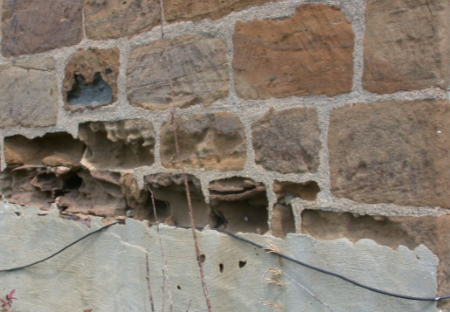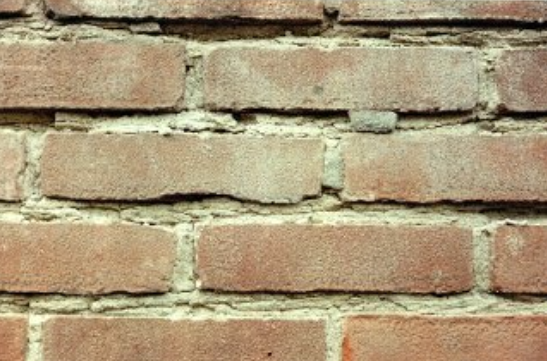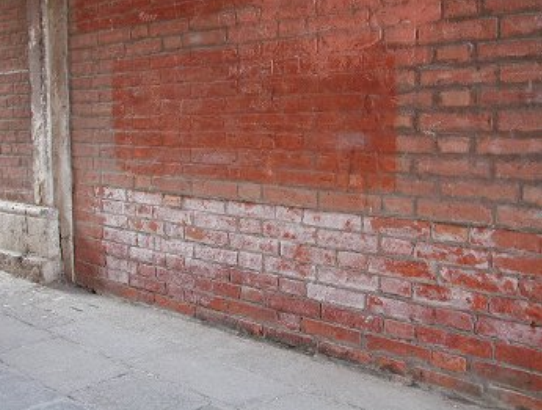Last updated: July 3, 2018
Article
This Masonry is for the Bees!

National Park Service
Home and business owners with historic masonry buildings such as the Stonehaus often make this mistake. Wanting to keep their building sound, they undertake what they believe to be responsible preventative maintenance to keep the masonry (brick or stone) from deteriorating further. This is done, unfortunately, without a good knowledge of how a masonry building acts and reacts to various treatments and the weather over time; or how a masonry building “breathes.” Plus, every hardware store in the country carries “quick-fix” remedies of all types for the “Do-it-Yourselfer.” Included are pre-packaged mortar repair “kits.” Unfortunately, these kits contain a high degree of portland cement, which produces a very hard surface. [2] This is fine for modern materials, and modern repair techniques, but is disastrous for older masonry buildings.

National Park Service
The new pointing mortar and parging material used on the Stonehaus contained a high degree of portland cement, verified by a physical test of these areas. Two problems contributing to the deterioration of the masonry immediately above the parged surface are apparent: 1) the parging ‐impervious to moisture ‐allowed ground water to “wick” up the masonry and concentrate immediately above the parged area. This action saturated the stone and began a process of breaking apart the chemical bonds holding the stone together, causing it to deteriorate; 2) the portland pointing mortar, which has a lower porosity than the sandstone, is much, much harder than the stone. As a building “moves” due to thermal expansion during the day and evening hours, the different hardness of adjacent materials causes one to “give” while the other remains constant. Another problem with the high portland procontent parging is that it cannot breathe (or allow the masonry behind it to breathe), moisture will be trapped in the stone behind this coating, causing the masonry to deteriorate at a highly accelerated rate. If we removed the portland parging, we would most likely find very poor quality sandstone, or perhaps only sandstone powder.

National Park Service

National Park Service
As with living organisms, historic masonry buildings must be allowed to breathe. When repairs are considered, coating with an impervious material such as high‐content portland cement is never recommended. If pointing is considered, a pointing mortar should be chosen that duplicates the old mortar in strength, composition, color, and texture. [5] Consult a preservation professional for appropriate mortar "recipes." If replacement materials (stone or brick) are required, a similar approach is necessary (choose masonry materials that duplicate the existing in strength, composition, color, and texture). Preservation Briefs No. 2 and 39 are excellent sources of information.
Originally published in "Exceptional Places" Vol. 2, 2007, a newsletter of the Division of Cultural Resources, Midwest Region. Written by Mark Chavez.
[1] Also known as “parget,” a mixture such as plaster or cement used to waterproof outer walls and line chimneys.
[2] “A History of Cement,” The Portland Cement Association, http://www.cement.org/index.asp
[3] For more information please refer to NPS Preservation Brief No. 2, “Repointing Mortar Joints in Historic Masonry Buildings,” Robert C. Mack, FAIA, and John P. Speweik; and NPS Preservation Brief No. 39, “Holding the Line: Controlling Unwanted Moisture in Historic Buildings, Sharon C. Park, AIA. National Park Service, Technical Preservation Services, http://www.nps.gov/history/hps/TPS/briefs/brief02.htm / ... brief39.htm
[4] Capillary action occurs when moisture in saturated porous building materials, such as masonry, wicks up or travels vertically as it evaporates to the surface. In capillary attraction, liquid in the material is attracted to the solid surface of the pore structure causing it to rise vertically; thus, it is often called "rising damp," particularly when found in conjunction with ground moisture.
[5] The Secretary of the Interior’s Standards for the Treatment of Historic Properties, masonry guidelines, http://www.nps.gov/history/hps/tps/standguide/preserve/preserve_masonry.htm
